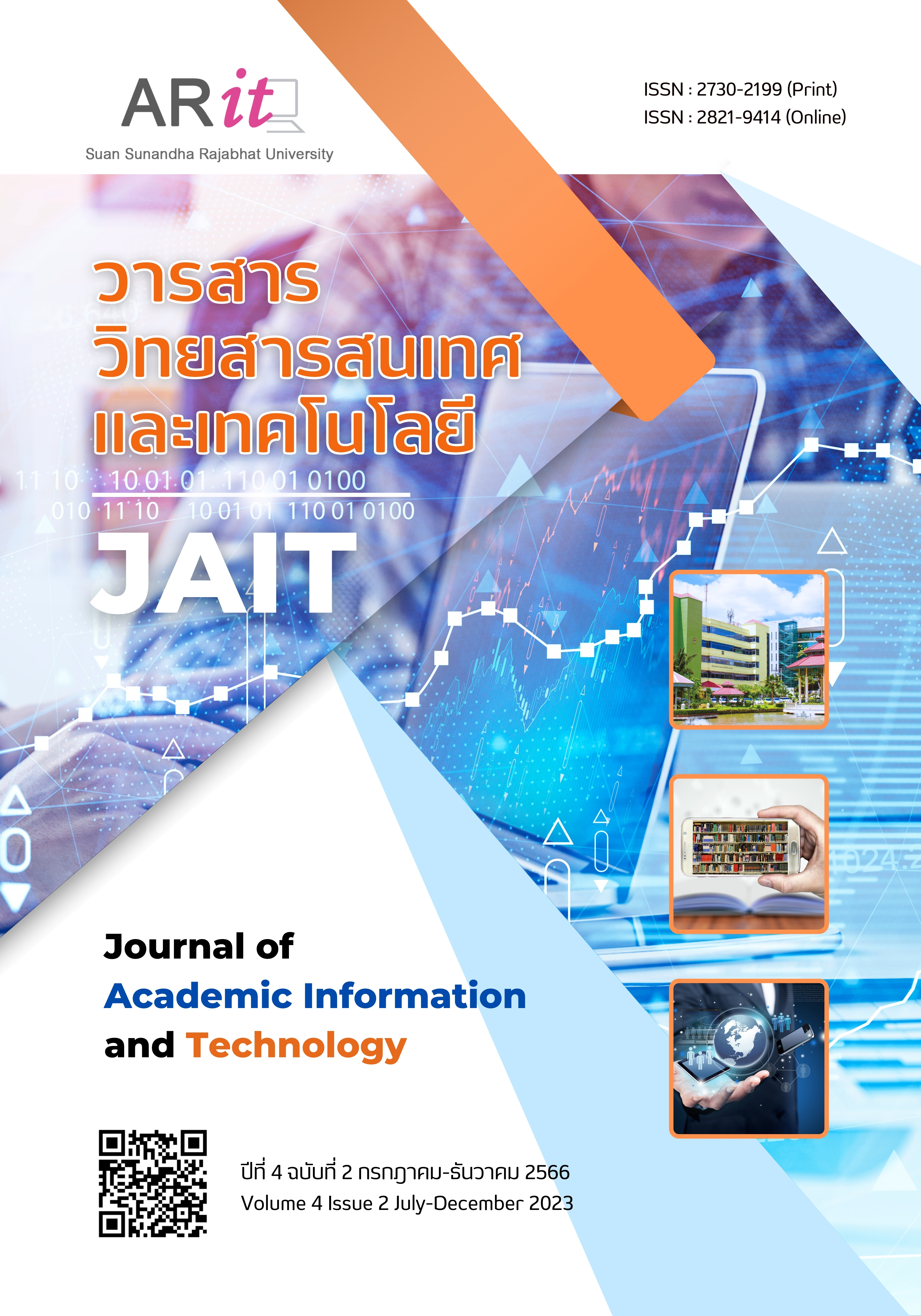The Development of Chatbot Application to Automatically Answer Questions of Learning Development Research for Graduated Students
Keywords:
Chatbot Application, Learning Development Research, Graduate StudentsAbstract
The objectives of this study were to examine the comprehension, challenges, and requirements of graduate students in conducting research on learning development, to create a chatbot application that can address inquiries from graduate students regarding research on learning development, and to investigate the level of satisfaction among graduate students with the chatbot application. The interviews with 5 instructors and 15 graduate students were conducted to investigate the comprehension, challenges, and requirements of the students. The chatbot application was specifically developed to tackle the challenges and requirements that were identified during the interviews. The study revealed that although the students understood the concept of learning development research, they lacked clarity regarding its methodology. The majority of individuals encountered challenges when initiating their study, doing information searches, and lacking comprehension of research technique, statistics, and data analysis. The chatbot application was developed to provide answers to students' inquiries regarding various aspects of research, including basic research, statistics and data analysis, research planning and beginning, research tool development and evaluation, research writing format and examples, as well as information searching and research publication. The satisfaction of 45 graduate students who had utilised the chatbot application was assessed and determined to be statistically significant, with an average rating of 4.55 and a standard deviation of 0.33.
References
แชทบอทคืออะไร? ตัวช่วยธุรกิจที่ขาดไม่ได้ในยุค Next normal. (2564, 20 ธันวาคม). Aigen. https:// aigencorp.com/what-is-chatbot/
ดวงมณี แสนมั่น, สุวนันท์ อุดมสุข, ลักษมณวดี ราชาธรรมกุล, ธนสาร ศิริรัตน์, ภาณุพงศ์ สหายสุข และสุชา จุลสําลี. (2564). การพัฒนาแอปพลิเคชันแชทบอทเพื่อตอบข้อสงสัยเกี่ยวกับนักเทคนิคการแพทย์. ใน เอกสารสืบเนื่องจากการประชุมวิชาการระดับชาติ ครั้งที่ 11 ด้านวิทยาศาสตร์และเทคโนโลยี มหาวิทยาลัยรังสิต ประจําปี 2564 (น. 65-77). มหาวิทยาลัยรังสิต.
มหาวิทยาลัยเทคโนโลยีพระจอมเกล้าธนบุรี. (2560). คู่มือการจัดการเรียนการสอน โครงการการพัฒนาแนวทางการจัดการเรียนการสอนและกิจกรรมเสริมหลักสูตรด้านความเป็นผู้ประกอบการ รายวิชากระบวนการคิดเชิงออกแบบ (Design thinking). http://www.gmi.kmutt.ac.th/public/upload/บริการวิชาการ/60/คู่มือการจัดการเรียนการสอน รายวิชา กระบวนการคิดเชิงออกแบบ (Design Thinking).pdf
ศศิธร สุพันทวี และภิรดา ชัยรัตน์. (2561). ปัญหาและอุปสรรคในการทำวิทยานิพนธ์ของนิสิตระดับบัณฑิตศึกษา โครงการศิลปศาสตรมหาบัณฑิตสาขาวิชารัฐศาสตร์ (ภาคพิเศษ) มหาวิทยาลัยเกษตรศาสตร์. วารสารสหวิทยาการวิจัย: ฉบับบัณฑิตศึกษา, 7(1), 198-203. https://so03.tci-thaijo.org/index.php/JIRGS/article/view/229587
ศิรัฐ อิ่มแช่ม และใจทิพย์ ณ สงขลา. (2563). ผลของการใช้แชทบอทที่มีการช่วยเสริมศักยภาพการเรียนรู้ออนไลน์ที่มีต่อการคิด เชิงคำนวณของนักเรียนระดับชั้นมัธยมศึกษาปีที่ 4 ที่มีบุคลิกภาพที่แตกต่างกัน. วารสารศึกษาศาสตร์ มสธ., 13(1), 45-57. https://so05.tci-thaijo.org/index.php/edjour_stou/article/view/231423
สรชัย พิศาลบุตร. (2555). การทำวิจัยในชั้นเรียน: เรียนรู้กันได้ใน 5 ชั่วโมง (พิมพ์ครั้งที่ 5). วิทยพัฒน์.
สุทธิกานต์ เลขาณุการ, พงศ์ประพันธ์ พงษ์โสภณ, ชาตรี ฝ่ายคําตา และเอกภูมิ จันทรขันตี. (2565). สมรรถนะการสอนการคิดเชิงออกแบบของครูวิทยาศาสตร์. วารสารศึกษาศาสตร์ มหาวิทยาลัยนเรศวร, 24(2), 370-380. https://so06.tci-thaijo.org/index.php/edujournal_nu/article/view/246374
สุนิสา ศรแก้ว. (2561). การยอมรับเทคโนโลยี Chatbot ในธุรกิจธนาคารในประเทศไทย [การค้นคว้าอิสระปริญญามหาบัณฑิต, มหาวิทยาลัยธรรมศาสตร์]. TU Digital Collections. https://digital.library.tu.ac.th/tu_dc/frontend/Info/item/dc:164045
สุภาภรณ์ ตั้งดำเนินสวัสดิ์. (2563). ปัญหาและความต้องการของผู้เรียนในการทำดุษฎีนิพนธ์ หลักสูตรศึกษาศาสตรดุษฎีบัณฑิต สาขาวิชาภาวะผู้นำทางการศึกษา. วารสารมหาจุฬาวิชาการ, 7(2), 94–106. https://so04.tci-thaijo.org/index.php/JMA/article/view/241516
สุมนา บุษบก, ณัฐพร เพ็ชรพงษ์ และจีรนุช สิงห์โตแก้ว. (2563). การพัฒนาแอปพลิเคชัน Chatbot สำหรับงานบริการนักศึกษา กรณีศึกษากองพัฒนานักศึกษา มหาวิทยาลัยเทคโนโลยีราชมงคลสุวรรณภูมิ. วารสารวิจัย มหาวิทยาลัยเทคโนโลยีราชมงคลธัญบุรี, 19(2), 85-94. https://ph01.tci-thaijo.org/index.php/rmutt-journal/article/view/240597
Colace, F., De Santo, M., Lombardi, M., Pascale, F., Pietrosanto, A., & Lemma, S. (2018). Chatbot for e-learning: A case of study. International Journal of Mechanical Engineering and Robotics Research, 7(5), 528-533. https://doi.org/10.18178/ijmerr.7.5.528-533
Courtney, J. [AJ&Smart]. (2020, February 4). What is design thinking? An overview [Video]. Youtube. https://www.youtube.com/watch?v=gHGN6hs2gZY
Dam, R. F., & Teo, Y. S. (2022, June 27). What is design thinking and why is it so popular? Interaction Design Foundation. https://www.interaction-design.org/literature/article/what-is-design-thinking-and-why-is-it-so-popular


